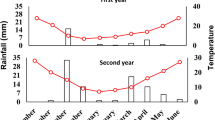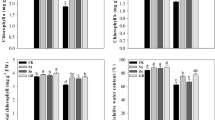Abstract
The study was conducted to investigate the ameliorative roles of GA3 and CK on adverse effects of drought in maize. Drought stressed maize plants were applied with GA3 and CK at 50, 100, and 150 mg L−l as foliar spray at the vegetative and the reproductive stages. Plant height, internode length, stem diameter, leaf chlorophyll index, and dry matter production were significantly affected by drought. In most cases, GA3 and CK significantly improved the depressed plant traits, but in varying degrees depending on the growth stage encountering hormones, and their types and concentrations. Both GA3 and CK were found to be very effective in alleviating drought-imposed adverse effects on maize at the vegetative phase. Such alleviating effects varied depending on the concentration of the hormones. Application of CK at 150 mg L−l was excellent resulting in a 106% yield advantage compared to drought stress and 79.9% increase relative to well-watered controls. Conversely, GA3 at 50 mg L−l performed well showing 78.8% increase in grain yield. However, both GA3 and CK had very little effect on improving the depressed growth and yield attributes in maize at the reproductive phase. The relative yield advantages for the hormones were mainly attributed to improving the cob and seed-bearing capacity of drought-stressed maize plants.
Similar content being viewed by others
References
Achard P, Cheng H, De Grauwe L, Decat J, Schoutteten H, Moritz T, Van Der Straeten D, Peng J, Harberd NP. 2006. Integration of plant responses to environmentally activated phytohormonal signals. Sci. 311: 91–94
Ashraf M. 2010. Inducing drought tolerance in plants: Recent Advances. Biotechnology Advances. 28: 169–183
Ashraf M, Karim F, Rasul E. 2002. Interactive effects of gibberellic acid (GA3) and salt stress on growth, ion accumulation and photosynthetic capacity of two spring wheat (Triticum aestivum L.) cultivars differing in salt tolerance. Plant Growth Regul. 36(1): 49–59
Ashraf M, Nawazish S, Athar HR. 2007. Are chlorophyll fluorescence and photosynthetic capacity, potential physiological determinants of drought tolerance in maize (Zea mays L.)? Pak. J. Bot. 39: 1123–1131
BARC (Bangladesh Agricultural Research Council). 2005. Fertilizer Recommendation Guide 2005. BARC, Farmgate, Dhaka-1215, Bangladesh
Bassetti P, Westgate ME. 1993. Water deficit affects receptivity of maize silks. Crop Sci. 33: 279–282
Bruce BW, Gregory OE, Barker TC. 2002. Molecular and physiological approaches to maize improvement for drought tolerance. J. Exp. Bot. 53: 13–25
Cakir R. 2004. Effect of water stress at different development stages on vegetative and reproductive growth of corn. Field Crops Res. 89: 1–16
Campos H, Cooper M, Habben JE, Edmeades GO, Schussler JR. 2004. Improving drought tolerance in maize: A view from industry. Field Crops Res. 90: 19–34
Figueiredo MVB, Vilar JJ, Burity HA, Franca FP. 1999. Alleviation of water stress effects in cowpea by Bradyrhizobium spp innoculation. Plant Soil 207: 67–75
Gadallah MAA. 1994. The combined effects of acidification stress and kinetin on chlorophyll content, dry matter accumulation and transpiration coefficient in sorghum bicolor plants. Biol Plant. 36: 149–153
Gadallah MAA. 1995. Effects of cadmium and kinetin on chlorophyll content, saccharides and dry matter accumulation in sunflower plants. Biol Plant. 37: 233–240
Hoque MA, Okuma E, Banu MNA, Nakamura Y, Shimoishi Y, Murata N. 2007. Exogenous proline mitigates the detrimental effects of salt stress more than exogenous betaine by increasing antioxidant enzyme activities. J. Plant Physiol. 164: 553–561
Hussain M, Malik MA, Farooq M, Ashraf MY, Cheema MA. 2008. Improving Drought tolerance by exogenous application of glycinebetaine and salicylic acid in sunflower. J. Agron. Crop Sci. 194: 193–199
Kamara AY, Menkir A, Badu-Apraku B, Ibikunle O. 2003. The influence of drought stress on growth, yield and yield components of selected maize genotypes. J. Agric. Sci. 141: 43–50
Kauser R, Athar HR, Ashraf M. 2006. Chlorophyll fluorescence: A potential indicator for assessment of water stress tolerance in canola (Brassica napus L.). Pak. J. Bot. 38: 1501–1509
Kaya MD, Okcub G, Ataka M, Cıkılıc Y, Kolsarıcıa O. 2006. Seed treatments to overcome salt and drought stress during germination in sunflower (Helianthus annuus L.). Eur. J. Agron. 24: 291–295
Laffitte HR, Edmeades GO. 1995. Stress tolerance in tropical maize is linked to constitutive change in ear growth characteristics. Crop Sci. 3: 820–826
Li JR, Yu K, Wei JR, Ma Q, Wang BQ, Yu D. 2010. Gibberellin retards chlorophyll degradation during senescence of Paris polyphylla. Biol. Plant. 54: 395–399
Maggio A, Barbieri G, Raimondi G, De Pascale S. 2010. Contrasting effects of GA3 treatments on tomato plants exposed to increasing salinity. J. Plant Growth Regul. 29: 63–72
Magome H, Yamaguchi S, Hanada A, Yuji Kamiya Y, Oda K. 2008. The DDF1 transcriptional activator upregulates expression of a gibberellin-deactivating gene, GA2ox7, under high-salinity stress in Arabidopsis. Plant J. 56: 613–626
Manivannan P, Jaleel CA, Kishorekumar A, Sankar B, Somasundaram R, Sridharan R, Panneerselvam R. 2007. Changes in antioxidant metabolism of Vigna unguiculata (L.) Walp. by propiconazole under water deficit stress. Colloids Surf. B: Biointerfaces. 57: 69–74
Monneveux P, Sanchez C, Beck D, Edmeades GO. 2006. Drought tolerance improvement in tropical maize source populations: evidence of progress. Crop Sci. 46: 180–191
Muoma J, Ombori O, Jesse M. 2010. Signal Transduction: One of the current molecular approaches in the management of drought stress in the Sub-Saharan region. Biotechnology 9: 469–476
Nanjo T, Fujita M, Seki M, Kato M, Tabata S, Shinozaki K. 2003. Toxicity of free proline revealed in an Arabidopsis TDNA-tagged mutant deficient in proline dehydrogenase. Plant Cell Physiol. 44: 541–548
Netting AG. 2000. pH, abscisic acid and the integration of metabolism in plants under stressed and non stressed conditions: Cellular responses to stress and their implication for plant water relations. J. Exp. Bot. 343: 147–158
Nunez-Elisea R and Davenport TL. 1983. Abscission and ethylene production of mango (Mangifera indica L.) fruit cv. Tommy Atkin. Proc. Florida State Hort. Soc. 96: 185–188
Raza SH, Athar HR, Ashraf M. 2006. Influence of exogenously applied glycinebetaine on the photosynthetic capacity of two differently adapted wheat cultivars under salt stress. Pak. J. Bot. 38: 341–352
Rodriguez AA, Stella AM, Storni MM, Zulpa G, Zaccaro MC. 2006. Effects of cyanobacterial extracellular products and gibberellic acid on salinity tolerance in Oryza sativa L. Saline Syst. 2: 7
Russel DF, Eisensmith SP. 1983. MSTAT-C. Crop and Soil Science Department. Michigan State University, USA
Saeidi-Sar S, Khavari-Nejad R, Fahimi H, Ghorbanli M, Majd A. 2007. Interactive effects of gibberellin A3 and ascorbic acid on lipid peroxidation and antioxidant enzyme activities in Glycine max seedlings under nickel stress. Russ. J. Plant Physiol. 54: 74–79
Schussler JR, Westgate ME. 1995. Assimilate flux determines kernel set at low water potential in maize. Crop Sci. 35: 1074–1080
Shao HB, Chu LY, Shao MA, Jaleel CA, Mi HM, Hong-Mei M. 2008. Higher plant antioxidants and redox signaling under environmental stresses. Comp. Rend. Biol. 331: 433–441
Synkova H, Wilhelmova N, Sestak Z, Pospisilova J. 1997. Photosynthesis in transgenic plants with elevated cytokinin contents. In M Pessarakli, ed, Handbook of Photosynthesis, Marcel Dekker, New York, Basel, Hong Kong, pp 541–552
Timsina J, Buresh RJ, Dobermann A, Dixon J. 2011. Ricemaize systems in Asia: current situation and potential, International Rice Research Institute and International Maize and Wheat Improvement Center, Los Banos, Philippines, pp 223–225
Tinker NA. 2002. Why quantitative geneticists should care about bioinformatics? In MS Kang, ed, Quantitative Genetics, Genomics and Plant Breeding. CABI, Wallingford, pp 33–44
Westgate ME. 1994. Water status and development of the maize endosperm and embryo during drought. Crop Sci. 34: 76–83
Zhang M, Duan L, Zhai Z, Li J, Tian X, Wang B, He Z, Li Z. 2004. Effects of plant growth regulators on water deficitinduced yield loss in soybean. Proceedings of the 4th International Crop Science Congress, Brisbane, Australia
Author information
Authors and Affiliations
Corresponding author
Rights and permissions
About this article
Cite this article
Akter, N., Rafiqul Islam, M., Abdul Karim, M. et al. Alleviation of drought stress in maize by exogenous application of gibberellic acid and cytokinin. J. Crop Sci. Biotechnol. 17, 41–48 (2014). https://doi.org/10.1007/s12892-013-0117-3
Received:
Revised:
Accepted:
Published:
Issue Date:
DOI: https://doi.org/10.1007/s12892-013-0117-3




